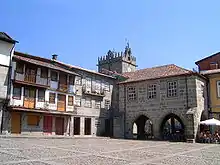Nicolinas
The Nicolinas (Portuguese: Festas Nicolinas) are the festivals of the students of Guimarães, celebrated in honor of Saint Nicholas. The first reference to the Nicolinas is in 1664, the year after the conclusion of the construction[1] of the Chapel of St. Nicholas in Guimarães.[2] In 1691, the first academic statutes appeared, the statutes of the Brotherhood of St. Nicholas.

History
The fact that a chapel in honor of Saint Nicholas was built in Guimarães in 1663 and the fact that the statutes of the Brotherhood of Saint Nicholas were created in 1691 are facts in themselves that reveal that the cult of Saint Nicholas in the city of Guimarães predated the 17th century, when it materialized in buildings and statutory documents. Historians place the beginning of the Nicolinas, not as such but as the beginning of the cult of St. Nicholas, during the 14th century, when the European cult of Saint Nicholas arrived in Guimarães.[3]
Festivities
.jpg.webp)
The Nicolinas Festivities are organized by the Nicolinas Festivities Committee, which is made up of male students from the Guimarães High School. Students from the Francisco de Holanda and Santos Simões high schools have also been given the opportunity to represent themselves on the committee. The festivities take place every year from November 29th to December 7th and are filled with various acts, from the Pinheiro and the Ceias Nicolinas, the most popular, to the Pregão.
Pinheiro and the Ceias Nicolinas
.jpg.webp)
It takes place on November 29th.[4] The burial of the Pinheiro (Pine Tree)[5] and the Ceias Nicolinas (Nicolinas' Supper)[6] kick off the celebrations in honor of Saint Nicholas. It is the most popular part of the Nicolinas Festivities being particularly popular between the youth of Guimarães. Traditionally, they eat rojões with broccoli rabe and papas de sarrabulho and drink Vinho Verde; after the end of the supper, everyone gathers at the Cano, next to São Mamede (where the Battle of São Mamede took place) and the Castle of Guimarães,[7] and begins the Pinheiro procession, with it being pulled by bulls throughout central Guimarães, to the sound of drums and boxes, chanting the characteristic "Toques Nicolinos". After the procession, the pine (traditionally the tallest pine tree in the region, offered by the Martins de Alvão family) is buried near the Santos Passos Church, marking the start of the Nicolinas.[8] Nowadays, people other than the students join in, most recently people from nearby towns and even people from the rest of the country participate too.
References
- http://www.monumentos.gov.pt/Site/APP_PagesUser/SIPA.aspx?id=16868
- "Festas Nicolinas". www.cm-guimaraes.pt (in European Portuguese). Retrieved 2023-10-23.
- "AAELG - Velhos Nicolinos - S. Nicolau". www.nicolinos.pt. Retrieved 2023-10-23.
- "AAELG - Velhos Nicolinos - Festas Nicolinas". www.nicolinos.pt. Retrieved 2023-10-23.
- "Pinheiro de Guimarães - Festas Nicolinas @ Natal • Lendas • Contos & Tradições". miluem.blogs.sapo.pt. Retrieved 2023-10-23.
- "AAELG - Velhos Nicolinos -". www.nicolinos.pt. Retrieved 2023-10-23.
- "Battle of São Mamede | Portuguese history | Britannica". www.britannica.com. Retrieved 2023-10-23.
- Paulo César Gonçalves, Gabriela Cunha. Manual (Para um pequeno) Nicolino.